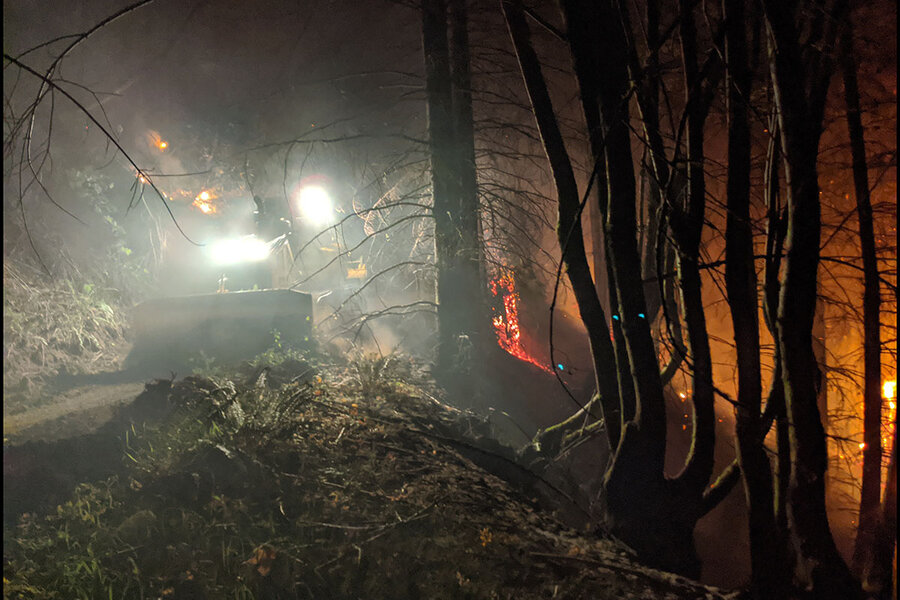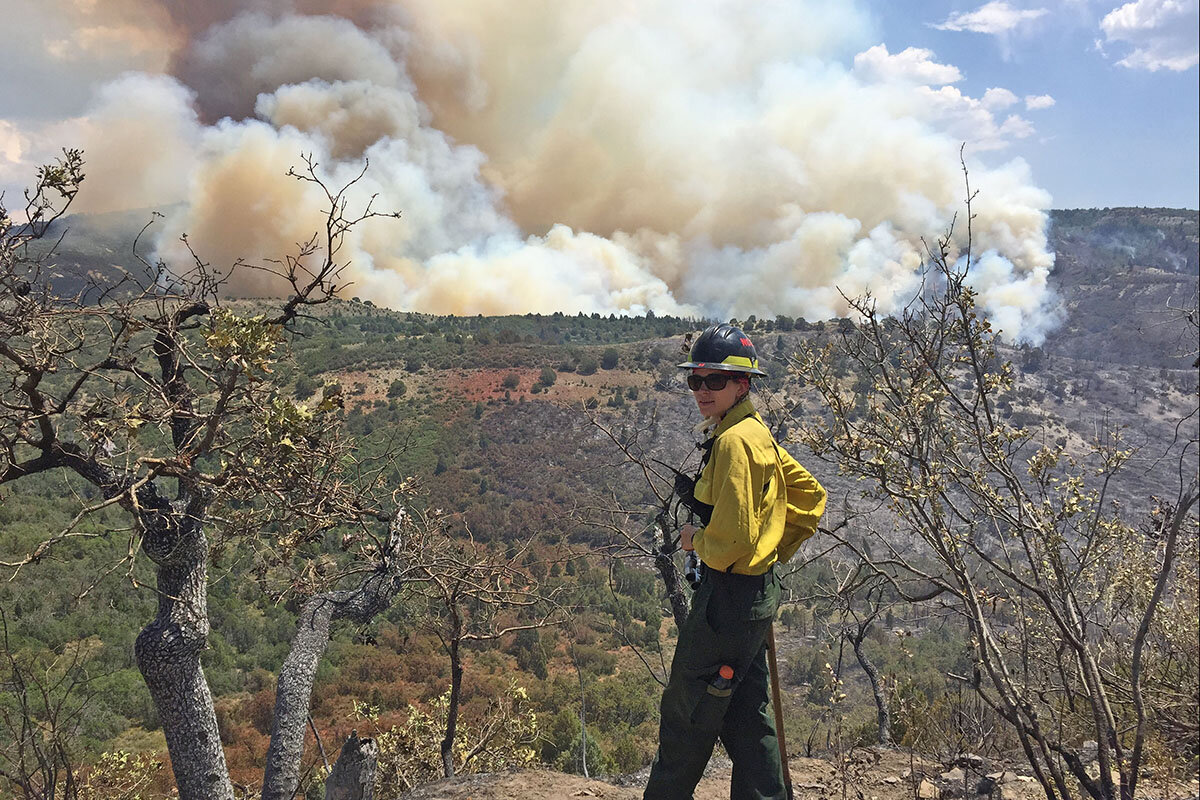As Oregon fights historic fires, college students on front lines
Loading...
| Portland, Ore.
Paul Catino’s summer internship has put him on the front lines of the West’s cataclysmic fire season.
He and other workers at timber company Campbell Global launched an initial attack against a wildfire on company land, working until the early morning hours with bulldozers with flashlights to clear a “contingency line” to box in the fire. He was back at it for five or six hours the next day, and the following day worked 12 to 15 hours.
“It was an unreal experience for me,” says Mr. Catino, a senior at Oregon State University in Corvallis majoring in forest management.
Why We Wrote This
College students make up 30% of Oregon’s wildland firefighters. For some, it’s a way to put their love of forestry into practice. For others, it’s a great way to pay for tuition while helping their state.
The Oregon Department of Forestry gave a shoutout to the company last week, saying that quick work by employees played a “huge role” in minimizing the fire’s footprint.
And Mr. Catino says he’s been thanked by several people who recognized his uniform at the Safeway in Sweet Home, Oregon.
“People have thanked me quite a bit. It’s very nice, especially now when so many communities have been affected,” says Mr. Catino, who is working on the Holiday Farm Fire. It’s one in a series of fires up and down the state that have burned about 1 million acres – nearly double the 10-year average.
With historic fires burning in Oregon, the state needs all hands on deck. So last week, Democratic Gov. Kate Brown put out the call to universities and colleges: Please don’t penalize students like Mr. Catino who are wildland firefighters for missing the start of classes. They’re needed on the front lines.
Seasonal firefighters make up the bulk of America’s forest firefighters, and college students play a critical role. In Oregon, upward of 30% of the crews that contractors put together are students. It’s high-paying work that can cover college tuition, but with longer fire seasons, it’s become a challenge for those who manage fires.
“Fire seasons have gotten longer and longer due to climate change and other factors,” says Sara Brown, manager for the National Forest Service’s fire, fuel, and smoke science program in Missoula, Montana. College students play a big role in wildland crews all over the country, she says, and the “million dollar question” is how agencies that deal with fire can adjust their work forces.
One idea gaining traction is professionalizing firefighting so there are fewer seasonal workers. Federal agencies are trying to increase the number of permanent employees through a wildfire apprenticeship program and conversion of temporary positions to permanent or permanent seasonal positions.
Risks and rewards
“I’ve been a professor and a college student, and it’s nearly impossible to say, hey, can we delay school for these few people?” says Dr. Brown, who fought fires all through college and into her master’s degree. “Students who come back late – several weeks, a month, maybe longer, there is no way to catch up.”
She has fond memories of firefighting. Having grown up in the rural town of Oakridge, Oregon, she loved the outdoor work, that it was physically challenging, that a crew could come together and do something greater than one single person. During her career, she served on a helicopter crew, a hotshot crew, and as a smoke jumper.
“I loved that it was a little bit dangerous,” she adds. She paid for that as a smoke jumper, when her parachute collided mid-air with her partner’s over the Gila Wilderness of New Mexico. She lost a leg because of it.
Today’s college students are well aware of the risks – and rewards – of their summer jobs. They learn about safety in training that typically lasts a week for beginning firefighters. Firefighting is grueling work with 12-hour days or more that can go for 14 days straight. Conditions can be smoky, dusty, and hot on remote, steep terrain. Wildland firefighters face the potential of a sudden wind shift and change in fire direction, rolling logs or rocks, stepping into a hole that’s a burning stump, and vehicle accidents.
When hazards include 300-foot trees
Corinne Heiner Buystedt, who just graduated from the forestry school at Oregon State University in Corvallis, recalls the summer of 2017, when she was on a crew in the state’s mountainous Three Sisters Wilderness. They worked late into the night to hand-dig a line to stop the fire’s advance in a heavily forested area, but had to return the next day.
That morning, she suddenly heard a crew above them start yelling. She looked up and saw a 300-foot cedar tree coming down on her and her crew. They yelled for everyone to run – she running perpendicular to the tree and those below her running downhill. The moment it hit the ground, she ran back to check on everyone. Within 30 seconds, the crew lined up. All were accounted for and there were no serious injuries.
“It was one of the scariest moments of my entire life,” she recalls. And yet, the recent graduate loves fighting fires. She loves the forest, true, but also the camaraderie and teamwork. “It’s kind of like a family.” By the time of the tree incident, she had been trained as a squad leader who manages a group of four to six people within a standard crew of 20. At first, it was hard to be taken seriously as a woman, she says, but after she earned her squad’s respect, “it was great.”
She describes her tree-episode squad as “really incredible,” but also traumatized as they continued working. “A lot of guys told me they didn’t want to go into a certain area unless they knew I was watching the back door – had my eyes on the fire behind them.”
With his study of forest management, Mr. Catino is disturbed by what he sees as a wasteful, reactive approach to fire, instead of a proactive one. Often, he says, he’ll go out on a fire and, in his view, the appropriate thing is to let it burn out rather than suppress it. But that’s not what the orders are.
This questioning is a good thing, says Randall Rosenberger, associate dean of student success at Oregon State University. “That’s where we get change,” as college students with firefighting experience move up into management across the fire field, he says.
Delayed start to the semester
Not all college-student firefighters are in forestry. Many are doing it because it can pay very well – especially in a busy fire season with overtime. With nowhere to go and nothing to spend it on, it’s not unusual for summer firefighters to make anywhere from $10,000 to $30,000 for three months work.
Porter Bovee, a friend of Mr. Catino’s at the university, is studying mechanical and manufacturing engineering, and is in his third summer of firefighting. He’s working about 100 hours a week, and thinks he will be able to cover tuition for the entire school year. “It’s a fun job,” he says at the end of a long day, “but it really is because of the money.”
Oregon state schools have an advantage over other schools when it comes to fire season. They are on the quarter system, which means they start at the end of September instead of August. Mr. Bovee’s last day will be Sept. 20, with classes resuming on Sept. 23. But a lot of people are just going to take the term off, he says, because the fire need is so great – and the earnings are so good. Mr. Catino says he’ll probably work until Oct. 1, then go back to school. He’s already been in touch with professors about it.
Indeed, the university tries to work with these students, urging professors to be flexible. They help students with course substitutions and even adjust scholarships. But the return to school is still a major concern for agencies and contractors that have to find the labor to fight fires in the fall.
“We are at max capacity,” says Bryan Wheelock, vice president at Grayback Forestry, a contractor in Medford, Oregon.
Over the years, the company has tried to adjust by screening college-student applicants more carefully about their planned return times, and providing housing to attract more candidates. Mr. Wheelock expects a good chunk of his college students will try to stay longer, but the company is looking to train another 10 to 20 firefighters to replace the students who are leaving.
“It’s a scramble to maintain full strength.”







